Diploma of Early Childhood Education - CHC50121 Assessment 3
VerifiedAdded on 2023/06/07
|23
|6149
|388
Homework Assignment
AI Summary
This document presents the solution for Assessment 3 of the CHC50121 Diploma of Early Childhood Education and Care program, specifically focusing on the 'Learning and curriculum in early childhood education – Cycle C' module. The assessment includes two parts, 3A and 3B, each containing knowledge questions designed to evaluate the student's understanding of the subject matter. The assessment covers various aspects of early childhood education, including curriculum planning, nurturing creativity, fostering holistic learning, and working in partnership with families. The document outlines assessment requirements, submission guidelines, and the assessment criteria. It also provides information on plagiarism, referencing, and the assessment outcome process, including resubmission attempts and appeals. The assessment aims to ensure that students have acquired the necessary knowledge and skills to meet the competency standards required for the diploma.

Paraphrase This Document
Need a fresh take? Get an instant paraphrase of this document with our AI Paraphraser
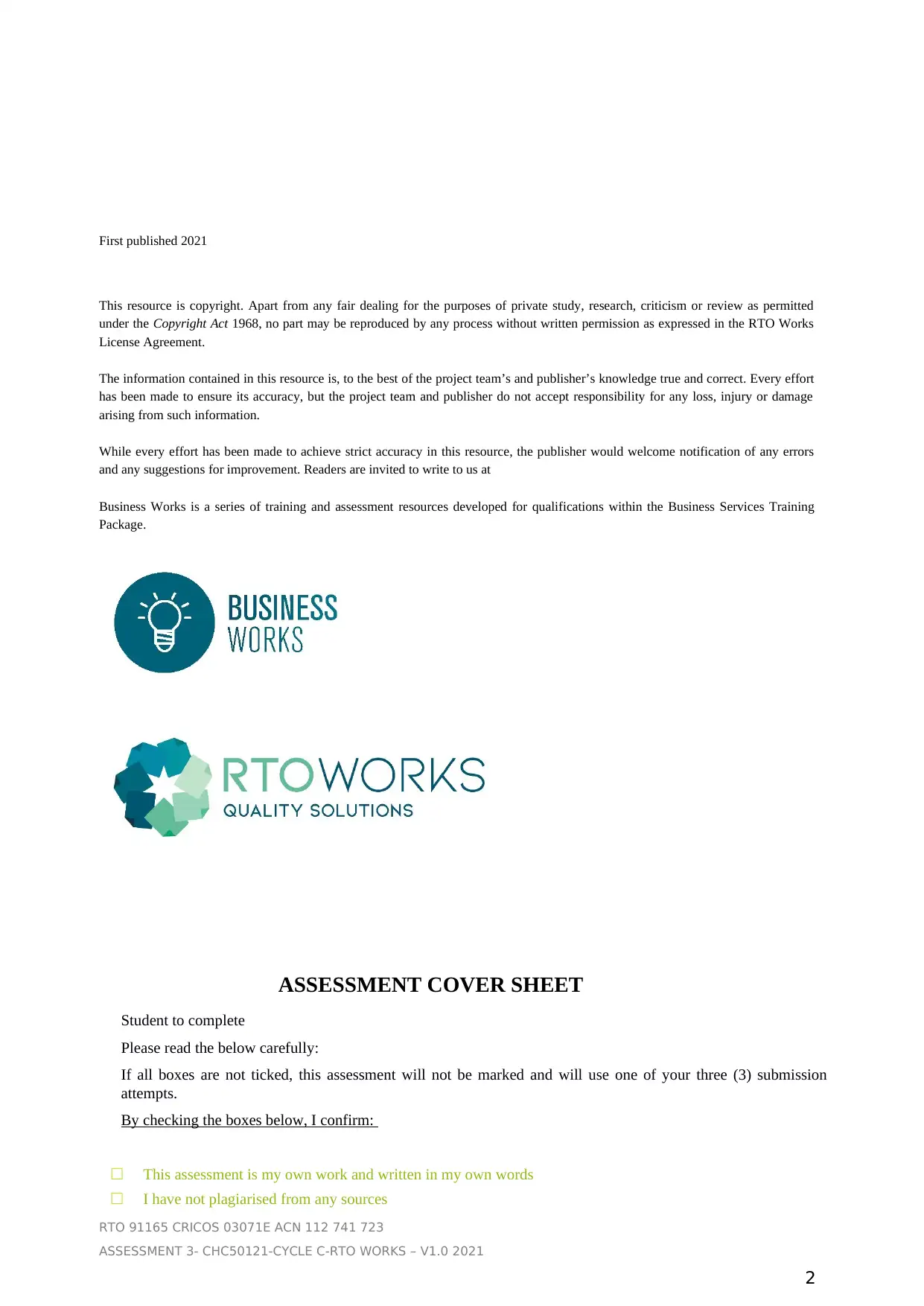
First published 2021
This resource is copyright. Apart from any fair dealing for the purposes of private study, research, criticism or review as permitted
under the Copyright Act 1968, no part may be reproduced by any process without written permission as expressed in the RTO Works
License Agreement.
The information contained in this resource is, to the best of the project team’s and publisher’s knowledge true and correct. Every effort
has been made to ensure its accuracy, but the project team and publisher do not accept responsibility for any loss, injury or damage
arising from such information.
While every effort has been made to achieve strict accuracy in this resource, the publisher would welcome notification of any errors
and any suggestions for improvement. Readers are invited to write to us at
Business Works is a series of training and assessment resources developed for qualifications within the Business Services Training
Package.
ASSESSMENT COVER SHEET
Student to complete
Please read the below carefully:
If all boxes are not ticked, this assessment will not be marked and will use one of your three (3) submission
attempts.
By checking the boxes below, I confirm:
☐ This assessment is my own work and written in my own words
☐ I have not plagiarised from any sources
RTO 91165 CRICOS 03071E ACN 112 741 723
ASSESSMENT 3- CHC50121-CYCLE C-RTO WORKS – V1.0 2021
2
This resource is copyright. Apart from any fair dealing for the purposes of private study, research, criticism or review as permitted
under the Copyright Act 1968, no part may be reproduced by any process without written permission as expressed in the RTO Works
License Agreement.
The information contained in this resource is, to the best of the project team’s and publisher’s knowledge true and correct. Every effort
has been made to ensure its accuracy, but the project team and publisher do not accept responsibility for any loss, injury or damage
arising from such information.
While every effort has been made to achieve strict accuracy in this resource, the publisher would welcome notification of any errors
and any suggestions for improvement. Readers are invited to write to us at
Business Works is a series of training and assessment resources developed for qualifications within the Business Services Training
Package.
ASSESSMENT COVER SHEET
Student to complete
Please read the below carefully:
If all boxes are not ticked, this assessment will not be marked and will use one of your three (3) submission
attempts.
By checking the boxes below, I confirm:
☐ This assessment is my own work and written in my own words
☐ I have not plagiarised from any sources
RTO 91165 CRICOS 03071E ACN 112 741 723
ASSESSMENT 3- CHC50121-CYCLE C-RTO WORKS – V1.0 2021
2
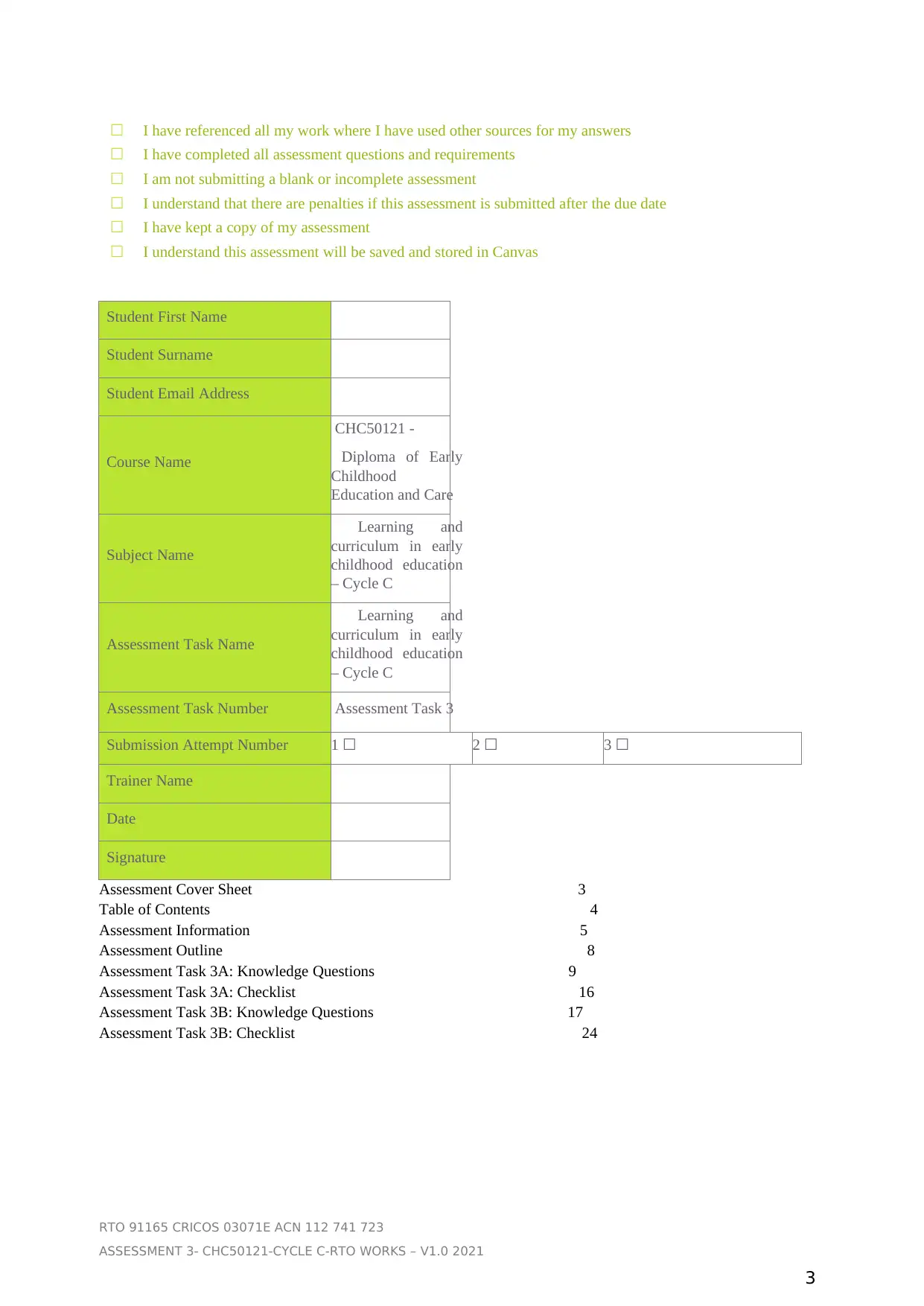
☐ I have referenced all my work where I have used other sources for my answers
☐ I have completed all assessment questions and requirements
☐ I am not submitting a blank or incomplete assessment
☐ I understand that there are penalties if this assessment is submitted after the due date
☐ I have kept a copy of my assessment
☐ I understand this assessment will be saved and stored in Canvas
TABLE OF CONTENTS
Assessment Cover Sheet 3
Table of Contents 4
Assessment Information 5
Assessment Outline 8
Assessment Task 3A: Knowledge Questions 9
Assessment Task 3A: Checklist 16
Assessment Task 3B: Knowledge Questions 17
Assessment Task 3B: Checklist 24
RTO 91165 CRICOS 03071E ACN 112 741 723
ASSESSMENT 3- CHC50121-CYCLE C-RTO WORKS – V1.0 2021
3
Student First Name
Student Surname
Student Email Address
Course Name
CHC50121 -
Diploma of Early
Childhood
Education and Care
Subject Name
Learning and
curriculum in early
childhood education
– Cycle C
Assessment Task Name
Learning and
curriculum in early
childhood education
– Cycle C
Assessment Task Number Assessment Task 3
Submission Attempt Number 1 ☐ 2 ☐ 3 ☐
Trainer Name
Date
Signature
☐ I have completed all assessment questions and requirements
☐ I am not submitting a blank or incomplete assessment
☐ I understand that there are penalties if this assessment is submitted after the due date
☐ I have kept a copy of my assessment
☐ I understand this assessment will be saved and stored in Canvas
TABLE OF CONTENTS
Assessment Cover Sheet 3
Table of Contents 4
Assessment Information 5
Assessment Outline 8
Assessment Task 3A: Knowledge Questions 9
Assessment Task 3A: Checklist 16
Assessment Task 3B: Knowledge Questions 17
Assessment Task 3B: Checklist 24
RTO 91165 CRICOS 03071E ACN 112 741 723
ASSESSMENT 3- CHC50121-CYCLE C-RTO WORKS – V1.0 2021
3
Student First Name
Student Surname
Student Email Address
Course Name
CHC50121 -
Diploma of Early
Childhood
Education and Care
Subject Name
Learning and
curriculum in early
childhood education
– Cycle C
Assessment Task Name
Learning and
curriculum in early
childhood education
– Cycle C
Assessment Task Number Assessment Task 3
Submission Attempt Number 1 ☐ 2 ☐ 3 ☐
Trainer Name
Date
Signature
⊘ This is a preview!⊘
Do you want full access?
Subscribe today to unlock all pages.

Trusted by 1+ million students worldwide
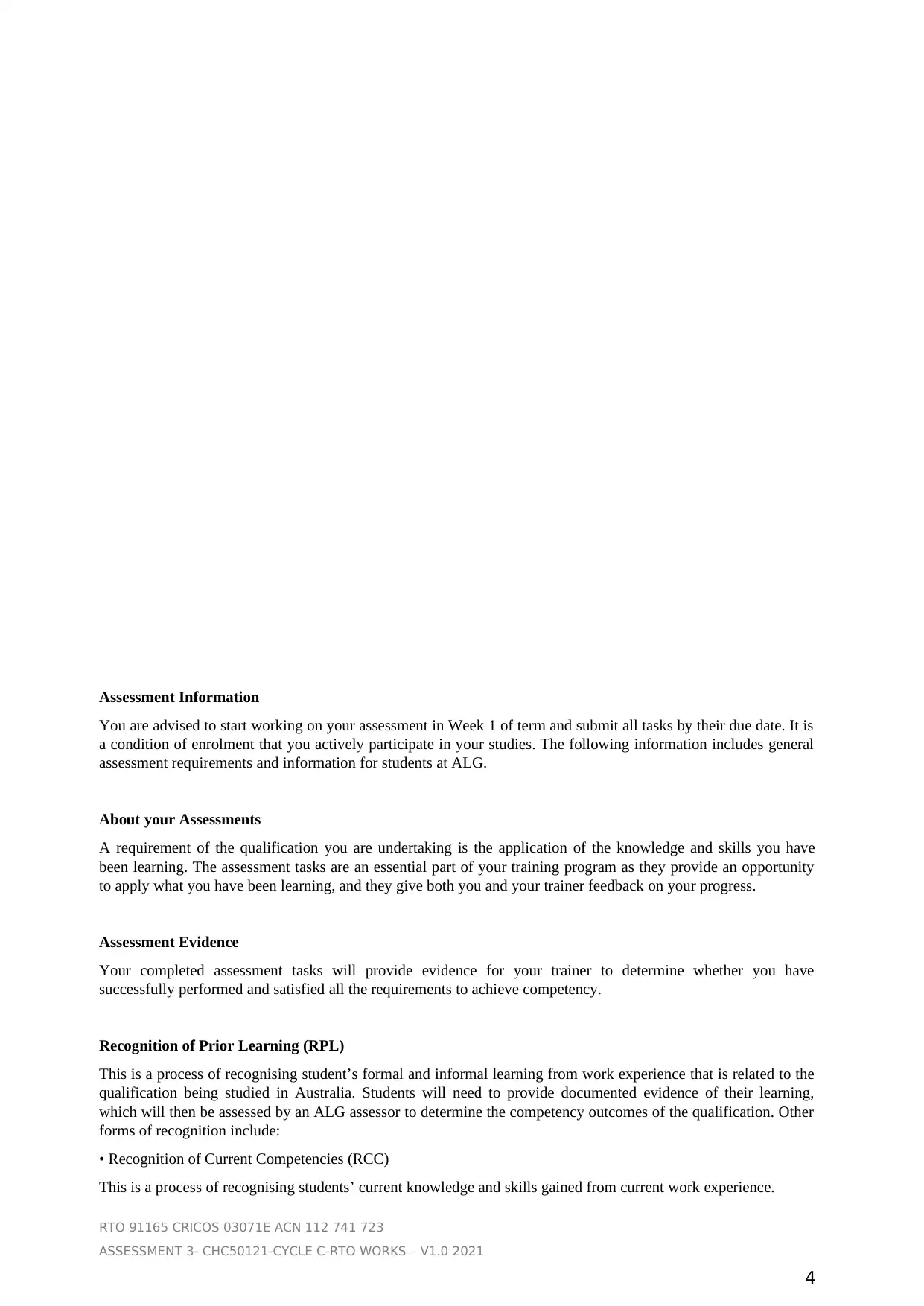
Assessment Information
You are advised to start working on your assessment in Week 1 of term and submit all tasks by their due date. It is
a condition of enrolment that you actively participate in your studies. The following information includes general
assessment requirements and information for students at ALG.
About your Assessments
A requirement of the qualification you are undertaking is the application of the knowledge and skills you have
been learning. The assessment tasks are an essential part of your training program as they provide an opportunity
to apply what you have been learning, and they give both you and your trainer feedback on your progress.
Assessment Evidence
Your completed assessment tasks will provide evidence for your trainer to determine whether you have
successfully performed and satisfied all the requirements to achieve competency.
Recognition of Prior Learning (RPL)
This is a process of recognising student’s formal and informal learning from work experience that is related to the
qualification being studied in Australia. Students will need to provide documented evidence of their learning,
which will then be assessed by an ALG assessor to determine the competency outcomes of the qualification. Other
forms of recognition include:
• Recognition of Current Competencies (RCC)
This is a process of recognising students’ current knowledge and skills gained from current work experience.
RTO 91165 CRICOS 03071E ACN 112 741 723
ASSESSMENT 3- CHC50121-CYCLE C-RTO WORKS – V1.0 2021
4
You are advised to start working on your assessment in Week 1 of term and submit all tasks by their due date. It is
a condition of enrolment that you actively participate in your studies. The following information includes general
assessment requirements and information for students at ALG.
About your Assessments
A requirement of the qualification you are undertaking is the application of the knowledge and skills you have
been learning. The assessment tasks are an essential part of your training program as they provide an opportunity
to apply what you have been learning, and they give both you and your trainer feedback on your progress.
Assessment Evidence
Your completed assessment tasks will provide evidence for your trainer to determine whether you have
successfully performed and satisfied all the requirements to achieve competency.
Recognition of Prior Learning (RPL)
This is a process of recognising student’s formal and informal learning from work experience that is related to the
qualification being studied in Australia. Students will need to provide documented evidence of their learning,
which will then be assessed by an ALG assessor to determine the competency outcomes of the qualification. Other
forms of recognition include:
• Recognition of Current Competencies (RCC)
This is a process of recognising students’ current knowledge and skills gained from current work experience.
RTO 91165 CRICOS 03071E ACN 112 741 723
ASSESSMENT 3- CHC50121-CYCLE C-RTO WORKS – V1.0 2021
4
Paraphrase This Document
Need a fresh take? Get an instant paraphrase of this document with our AI Paraphraser
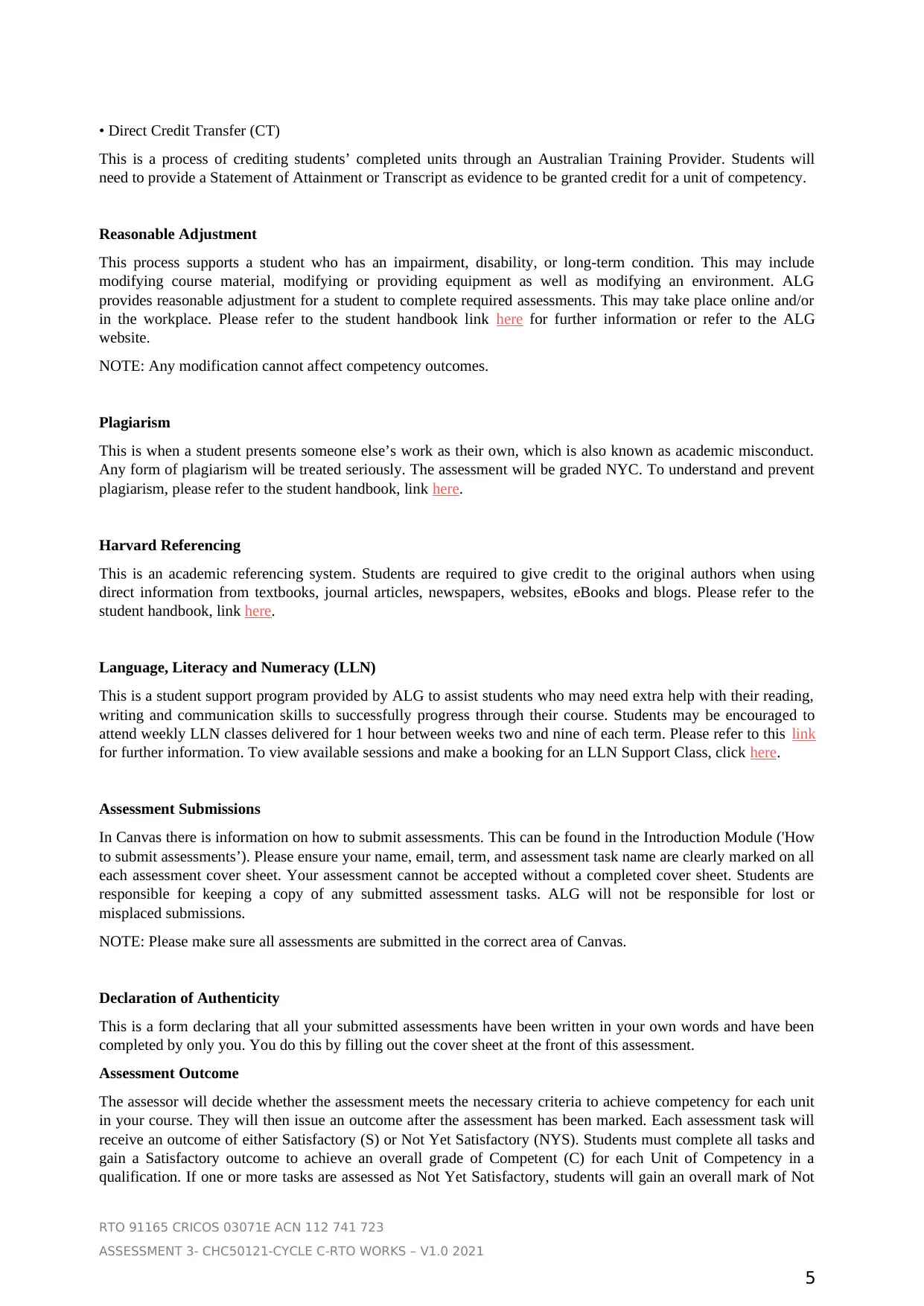
• Direct Credit Transfer (CT)
This is a process of crediting students’ completed units through an Australian Training Provider. Students will
need to provide a Statement of Attainment or Transcript as evidence to be granted credit for a unit of competency.
Reasonable Adjustment
This process supports a student who has an impairment, disability, or long-term condition. This may include
modifying course material, modifying or providing equipment as well as modifying an environment. ALG
provides reasonable adjustment for a student to complete required assessments. This may take place online and/or
in the workplace. Please refer to the student handbook link here for further information or refer to the ALG
website.
NOTE: Any modification cannot affect competency outcomes.
Plagiarism
This is when a student presents someone else’s work as their own, which is also known as academic misconduct.
Any form of plagiarism will be treated seriously. The assessment will be graded NYC. To understand and prevent
plagiarism, please refer to the student handbook, link here.
Harvard Referencing
This is an academic referencing system. Students are required to give credit to the original authors when using
direct information from textbooks, journal articles, newspapers, websites, eBooks and blogs. Please refer to the
student handbook, link here.
Language, Literacy and Numeracy (LLN)
This is a student support program provided by ALG to assist students who may need extra help with their reading,
writing and communication skills to successfully progress through their course. Students may be encouraged to
attend weekly LLN classes delivered for 1 hour between weeks two and nine of each term. Please refer to this link
for further information. To view available sessions and make a booking for an LLN Support Class, click here.
Assessment Submissions
In Canvas there is information on how to submit assessments. This can be found in the Introduction Module ('How
to submit assessments’). Please ensure your name, email, term, and assessment task name are clearly marked on all
each assessment cover sheet. Your assessment cannot be accepted without a completed cover sheet. Students are
responsible for keeping a copy of any submitted assessment tasks. ALG will not be responsible for lost or
misplaced submissions.
NOTE: Please make sure all assessments are submitted in the correct area of Canvas.
Declaration of Authenticity
This is a form declaring that all your submitted assessments have been written in your own words and have been
completed by only you. You do this by filling out the cover sheet at the front of this assessment.
Assessment Outcome
The assessor will decide whether the assessment meets the necessary criteria to achieve competency for each unit
in your course. They will then issue an outcome after the assessment has been marked. Each assessment task will
receive an outcome of either Satisfactory (S) or Not Yet Satisfactory (NYS). Students must complete all tasks and
gain a Satisfactory outcome to achieve an overall grade of Competent (C) for each Unit of Competency in a
qualification. If one or more tasks are assessed as Not Yet Satisfactory, students will gain an overall mark of Not
RTO 91165 CRICOS 03071E ACN 112 741 723
ASSESSMENT 3- CHC50121-CYCLE C-RTO WORKS – V1.0 2021
5
This is a process of crediting students’ completed units through an Australian Training Provider. Students will
need to provide a Statement of Attainment or Transcript as evidence to be granted credit for a unit of competency.
Reasonable Adjustment
This process supports a student who has an impairment, disability, or long-term condition. This may include
modifying course material, modifying or providing equipment as well as modifying an environment. ALG
provides reasonable adjustment for a student to complete required assessments. This may take place online and/or
in the workplace. Please refer to the student handbook link here for further information or refer to the ALG
website.
NOTE: Any modification cannot affect competency outcomes.
Plagiarism
This is when a student presents someone else’s work as their own, which is also known as academic misconduct.
Any form of plagiarism will be treated seriously. The assessment will be graded NYC. To understand and prevent
plagiarism, please refer to the student handbook, link here.
Harvard Referencing
This is an academic referencing system. Students are required to give credit to the original authors when using
direct information from textbooks, journal articles, newspapers, websites, eBooks and blogs. Please refer to the
student handbook, link here.
Language, Literacy and Numeracy (LLN)
This is a student support program provided by ALG to assist students who may need extra help with their reading,
writing and communication skills to successfully progress through their course. Students may be encouraged to
attend weekly LLN classes delivered for 1 hour between weeks two and nine of each term. Please refer to this link
for further information. To view available sessions and make a booking for an LLN Support Class, click here.
Assessment Submissions
In Canvas there is information on how to submit assessments. This can be found in the Introduction Module ('How
to submit assessments’). Please ensure your name, email, term, and assessment task name are clearly marked on all
each assessment cover sheet. Your assessment cannot be accepted without a completed cover sheet. Students are
responsible for keeping a copy of any submitted assessment tasks. ALG will not be responsible for lost or
misplaced submissions.
NOTE: Please make sure all assessments are submitted in the correct area of Canvas.
Declaration of Authenticity
This is a form declaring that all your submitted assessments have been written in your own words and have been
completed by only you. You do this by filling out the cover sheet at the front of this assessment.
Assessment Outcome
The assessor will decide whether the assessment meets the necessary criteria to achieve competency for each unit
in your course. They will then issue an outcome after the assessment has been marked. Each assessment task will
receive an outcome of either Satisfactory (S) or Not Yet Satisfactory (NYS). Students must complete all tasks and
gain a Satisfactory outcome to achieve an overall grade of Competent (C) for each Unit of Competency in a
qualification. If one or more tasks are assessed as Not Yet Satisfactory, students will gain an overall mark of Not
RTO 91165 CRICOS 03071E ACN 112 741 723
ASSESSMENT 3- CHC50121-CYCLE C-RTO WORKS – V1.0 2021
5
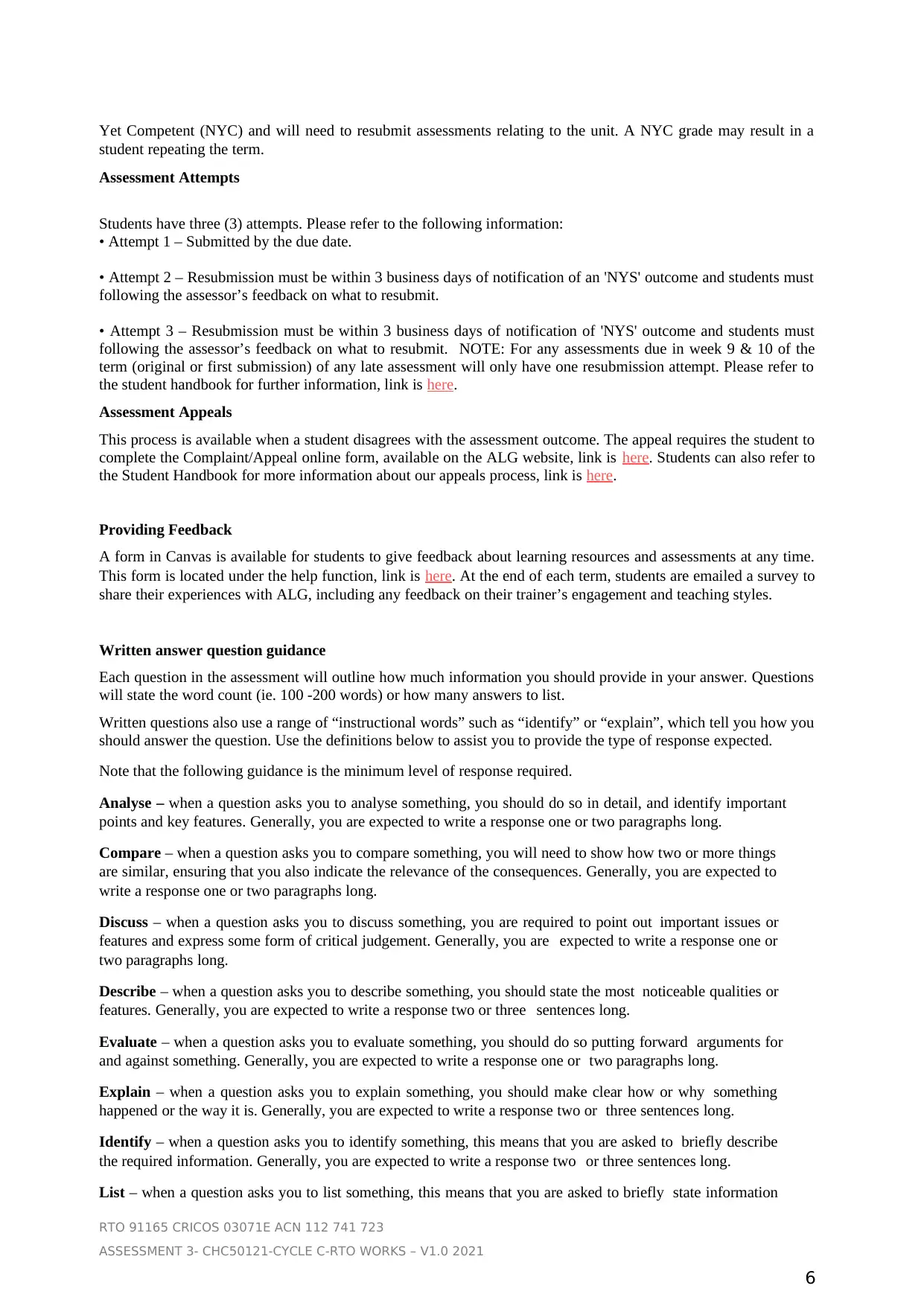
Yet Competent (NYC) and will need to resubmit assessments relating to the unit. A NYC grade may result in a
student repeating the term.
Assessment Attempts
Students have three (3) attempts. Please refer to the following information:
• Attempt 1 – Submitted by the due date.
• Attempt 2 – Resubmission must be within 3 business days of notification of an 'NYS' outcome and students must
following the assessor’s feedback on what to resubmit.
• Attempt 3 – Resubmission must be within 3 business days of notification of 'NYS' outcome and students must
following the assessor’s feedback on what to resubmit. NOTE: For any assessments due in week 9 & 10 of the
term (original or first submission) of any late assessment will only have one resubmission attempt. Please refer to
the student handbook for further information, link is here.
Assessment Appeals
This process is available when a student disagrees with the assessment outcome. The appeal requires the student to
complete the Complaint/Appeal online form, available on the ALG website, link is here. Students can also refer to
the Student Handbook for more information about our appeals process, link is here.
Providing Feedback
A form in Canvas is available for students to give feedback about learning resources and assessments at any time.
This form is located under the help function, link is here. At the end of each term, students are emailed a survey to
share their experiences with ALG, including any feedback on their trainer’s engagement and teaching styles.
Written answer question guidance
Each question in the assessment will outline how much information you should provide in your answer. Questions
will state the word count (ie. 100 -200 words) or how many answers to list.
Written questions also use a range of “instructional words” such as “identify” or “explain”, which tell you how you
should answer the question. Use the definitions below to assist you to provide the type of response expected.
Note that the following guidance is the minimum level of response required.
Analyse – when a question asks you to analyse something, you should do so in detail, and identify important
points and key features. Generally, you are expected to write a response one or two paragraphs long.
Compare – when a question asks you to compare something, you will need to show how two or more things
are similar, ensuring that you also indicate the relevance of the consequences. Generally, you are expected to
write a response one or two paragraphs long.
Discuss – when a question asks you to discuss something, you are required to point out important issues or
features and express some form of critical judgement. Generally, you are expected to write a response one or
two paragraphs long.
Describe – when a question asks you to describe something, you should state the most noticeable qualities or
features. Generally, you are expected to write a response two or three sentences long.
Evaluate – when a question asks you to evaluate something, you should do so putting forward arguments for
and against something. Generally, you are expected to write a response one or two paragraphs long.
Explain – when a question asks you to explain something, you should make clear how or why something
happened or the way it is. Generally, you are expected to write a response two or three sentences long.
Identify – when a question asks you to identify something, this means that you are asked to briefly describe
the required information. Generally, you are expected to write a response two or three sentences long.
List – when a question asks you to list something, this means that you are asked to briefly state information
RTO 91165 CRICOS 03071E ACN 112 741 723
ASSESSMENT 3- CHC50121-CYCLE C-RTO WORKS – V1.0 2021
6
student repeating the term.
Assessment Attempts
Students have three (3) attempts. Please refer to the following information:
• Attempt 1 – Submitted by the due date.
• Attempt 2 – Resubmission must be within 3 business days of notification of an 'NYS' outcome and students must
following the assessor’s feedback on what to resubmit.
• Attempt 3 – Resubmission must be within 3 business days of notification of 'NYS' outcome and students must
following the assessor’s feedback on what to resubmit. NOTE: For any assessments due in week 9 & 10 of the
term (original or first submission) of any late assessment will only have one resubmission attempt. Please refer to
the student handbook for further information, link is here.
Assessment Appeals
This process is available when a student disagrees with the assessment outcome. The appeal requires the student to
complete the Complaint/Appeal online form, available on the ALG website, link is here. Students can also refer to
the Student Handbook for more information about our appeals process, link is here.
Providing Feedback
A form in Canvas is available for students to give feedback about learning resources and assessments at any time.
This form is located under the help function, link is here. At the end of each term, students are emailed a survey to
share their experiences with ALG, including any feedback on their trainer’s engagement and teaching styles.
Written answer question guidance
Each question in the assessment will outline how much information you should provide in your answer. Questions
will state the word count (ie. 100 -200 words) or how many answers to list.
Written questions also use a range of “instructional words” such as “identify” or “explain”, which tell you how you
should answer the question. Use the definitions below to assist you to provide the type of response expected.
Note that the following guidance is the minimum level of response required.
Analyse – when a question asks you to analyse something, you should do so in detail, and identify important
points and key features. Generally, you are expected to write a response one or two paragraphs long.
Compare – when a question asks you to compare something, you will need to show how two or more things
are similar, ensuring that you also indicate the relevance of the consequences. Generally, you are expected to
write a response one or two paragraphs long.
Discuss – when a question asks you to discuss something, you are required to point out important issues or
features and express some form of critical judgement. Generally, you are expected to write a response one or
two paragraphs long.
Describe – when a question asks you to describe something, you should state the most noticeable qualities or
features. Generally, you are expected to write a response two or three sentences long.
Evaluate – when a question asks you to evaluate something, you should do so putting forward arguments for
and against something. Generally, you are expected to write a response one or two paragraphs long.
Explain – when a question asks you to explain something, you should make clear how or why something
happened or the way it is. Generally, you are expected to write a response two or three sentences long.
Identify – when a question asks you to identify something, this means that you are asked to briefly describe
the required information. Generally, you are expected to write a response two or three sentences long.
List – when a question asks you to list something, this means that you are asked to briefly state information
RTO 91165 CRICOS 03071E ACN 112 741 723
ASSESSMENT 3- CHC50121-CYCLE C-RTO WORKS – V1.0 2021
6
⊘ This is a preview!⊘
Do you want full access?
Subscribe today to unlock all pages.

Trusted by 1+ million students worldwide
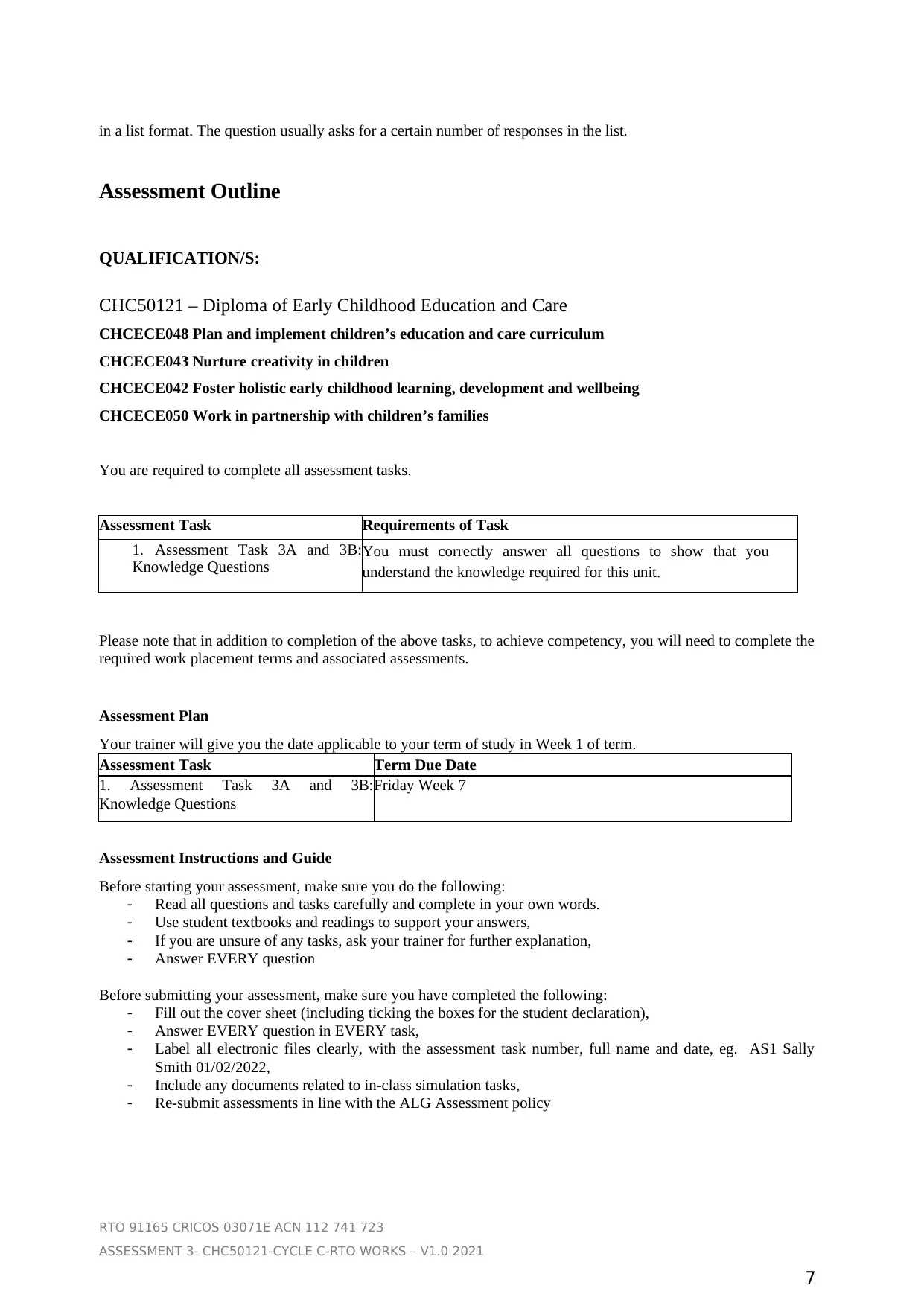
in a list format. The question usually asks for a certain number of responses in the list.
Assessment Outline
QUALIFICATION/S:
CHC50121 – Diploma of Early Childhood Education and Care
CHCECE048 Plan and implement children’s education and care curriculum
CHCECE043 Nurture creativity in children
CHCECE042 Foster holistic early childhood learning, development and wellbeing
CHCECE050 Work in partnership with children’s families
You are required to complete all assessment tasks.
Assessment Task Requirements of Task
1. Assessment Task 3A and 3B:
Knowledge Questions
You must correctly answer all questions to show that you
understand the knowledge required for this unit.
Please note that in addition to completion of the above tasks, to achieve competency, you will need to complete the
required work placement terms and associated assessments.
Assessment Plan
Your trainer will give you the date applicable to your term of study in Week 1 of term.
Assessment Task Term Due Date
1. Assessment Task 3A and 3B:
Knowledge Questions
Friday Week 7
Assessment Instructions and Guide
Before starting your assessment, make sure you do the following:
- Read all questions and tasks carefully and complete in your own words.
- Use student textbooks and readings to support your answers,
- If you are unsure of any tasks, ask your trainer for further explanation,
- Answer EVERY question
Before submitting your assessment, make sure you have completed the following:
- Fill out the cover sheet (including ticking the boxes for the student declaration),
- Answer EVERY question in EVERY task,
- Label all electronic files clearly, with the assessment task number, full name and date, eg. AS1 Sally
Smith 01/02/2022,
- Include any documents related to in-class simulation tasks,
- Re-submit assessments in line with the ALG Assessment policy
RTO 91165 CRICOS 03071E ACN 112 741 723
ASSESSMENT 3- CHC50121-CYCLE C-RTO WORKS – V1.0 2021
7
Assessment Outline
QUALIFICATION/S:
CHC50121 – Diploma of Early Childhood Education and Care
CHCECE048 Plan and implement children’s education and care curriculum
CHCECE043 Nurture creativity in children
CHCECE042 Foster holistic early childhood learning, development and wellbeing
CHCECE050 Work in partnership with children’s families
You are required to complete all assessment tasks.
Assessment Task Requirements of Task
1. Assessment Task 3A and 3B:
Knowledge Questions
You must correctly answer all questions to show that you
understand the knowledge required for this unit.
Please note that in addition to completion of the above tasks, to achieve competency, you will need to complete the
required work placement terms and associated assessments.
Assessment Plan
Your trainer will give you the date applicable to your term of study in Week 1 of term.
Assessment Task Term Due Date
1. Assessment Task 3A and 3B:
Knowledge Questions
Friday Week 7
Assessment Instructions and Guide
Before starting your assessment, make sure you do the following:
- Read all questions and tasks carefully and complete in your own words.
- Use student textbooks and readings to support your answers,
- If you are unsure of any tasks, ask your trainer for further explanation,
- Answer EVERY question
Before submitting your assessment, make sure you have completed the following:
- Fill out the cover sheet (including ticking the boxes for the student declaration),
- Answer EVERY question in EVERY task,
- Label all electronic files clearly, with the assessment task number, full name and date, eg. AS1 Sally
Smith 01/02/2022,
- Include any documents related to in-class simulation tasks,
- Re-submit assessments in line with the ALG Assessment policy
RTO 91165 CRICOS 03071E ACN 112 741 723
ASSESSMENT 3- CHC50121-CYCLE C-RTO WORKS – V1.0 2021
7
Paraphrase This Document
Need a fresh take? Get an instant paraphrase of this document with our AI Paraphraser
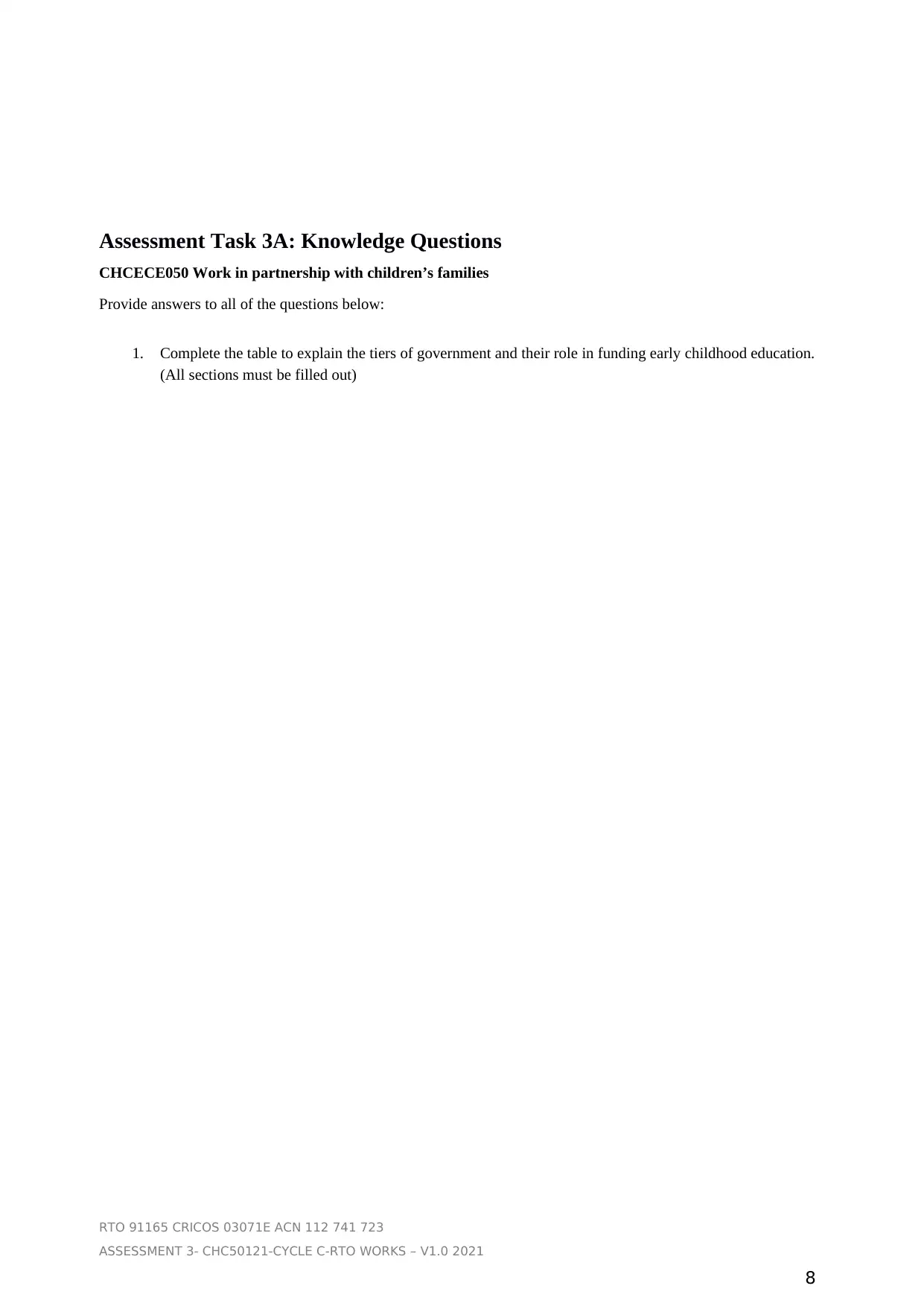
Assessment Task 3A: Knowledge Questions
CHCECE050 Work in partnership with children’s families
Provide answers to all of the questions below:
1. Complete the table to explain the tiers of government and their role in funding early childhood education.
(All sections must be filled out)
RTO 91165 CRICOS 03071E ACN 112 741 723
ASSESSMENT 3- CHC50121-CYCLE C-RTO WORKS – V1.0 2021
8
CHCECE050 Work in partnership with children’s families
Provide answers to all of the questions below:
1. Complete the table to explain the tiers of government and their role in funding early childhood education.
(All sections must be filled out)
RTO 91165 CRICOS 03071E ACN 112 741 723
ASSESSMENT 3- CHC50121-CYCLE C-RTO WORKS – V1.0 2021
8
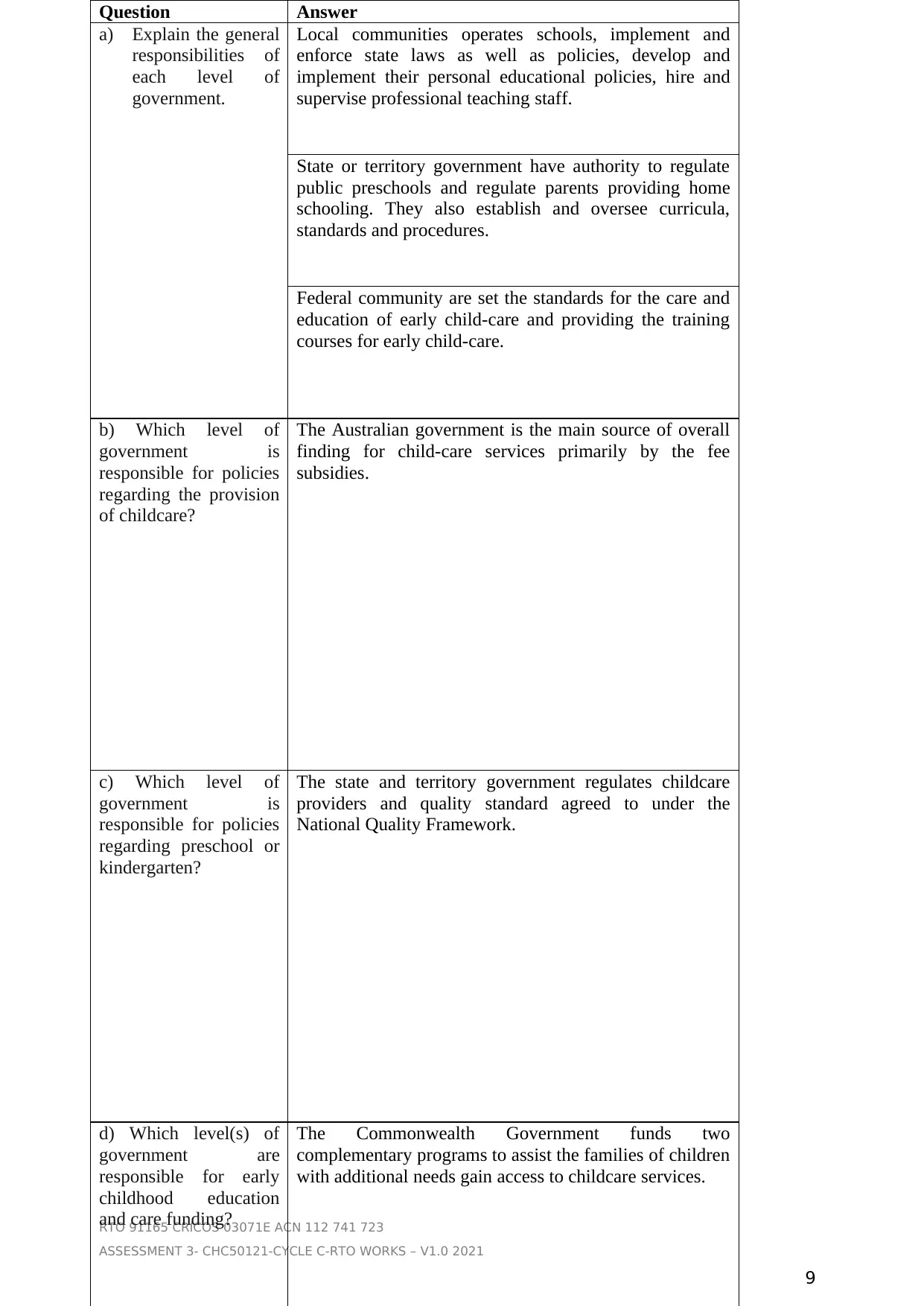
RTO 91165 CRICOS 03071E ACN 112 741 723
ASSESSMENT 3- CHC50121-CYCLE C-RTO WORKS – V1.0 2021
9
Question Answer
a) Explain the general
responsibilities of
each level of
government.
Local communities operates schools, implement and
enforce state laws as well as policies, develop and
implement their personal educational policies, hire and
supervise professional teaching staff.
State or territory government have authority to regulate
public preschools and regulate parents providing home
schooling. They also establish and oversee curricula,
standards and procedures.
Federal community are set the standards for the care and
education of early child-care and providing the training
courses for early child-care.
b) Which level of
government is
responsible for policies
regarding the provision
of childcare?
The Australian government is the main source of overall
finding for child-care services primarily by the fee
subsidies.
c) Which level of
government is
responsible for policies
regarding preschool or
kindergarten?
The state and territory government regulates childcare
providers and quality standard agreed to under the
National Quality Framework.
d) Which level(s) of
government are
responsible for early
childhood education
and care funding?
The Commonwealth Government funds two
complementary programs to assist the families of children
with additional needs gain access to childcare services.
ASSESSMENT 3- CHC50121-CYCLE C-RTO WORKS – V1.0 2021
9
Question Answer
a) Explain the general
responsibilities of
each level of
government.
Local communities operates schools, implement and
enforce state laws as well as policies, develop and
implement their personal educational policies, hire and
supervise professional teaching staff.
State or territory government have authority to regulate
public preschools and regulate parents providing home
schooling. They also establish and oversee curricula,
standards and procedures.
Federal community are set the standards for the care and
education of early child-care and providing the training
courses for early child-care.
b) Which level of
government is
responsible for policies
regarding the provision
of childcare?
The Australian government is the main source of overall
finding for child-care services primarily by the fee
subsidies.
c) Which level of
government is
responsible for policies
regarding preschool or
kindergarten?
The state and territory government regulates childcare
providers and quality standard agreed to under the
National Quality Framework.
d) Which level(s) of
government are
responsible for early
childhood education
and care funding?
The Commonwealth Government funds two
complementary programs to assist the families of children
with additional needs gain access to childcare services.
⊘ This is a preview!⊘
Do you want full access?
Subscribe today to unlock all pages.

Trusted by 1+ million students worldwide
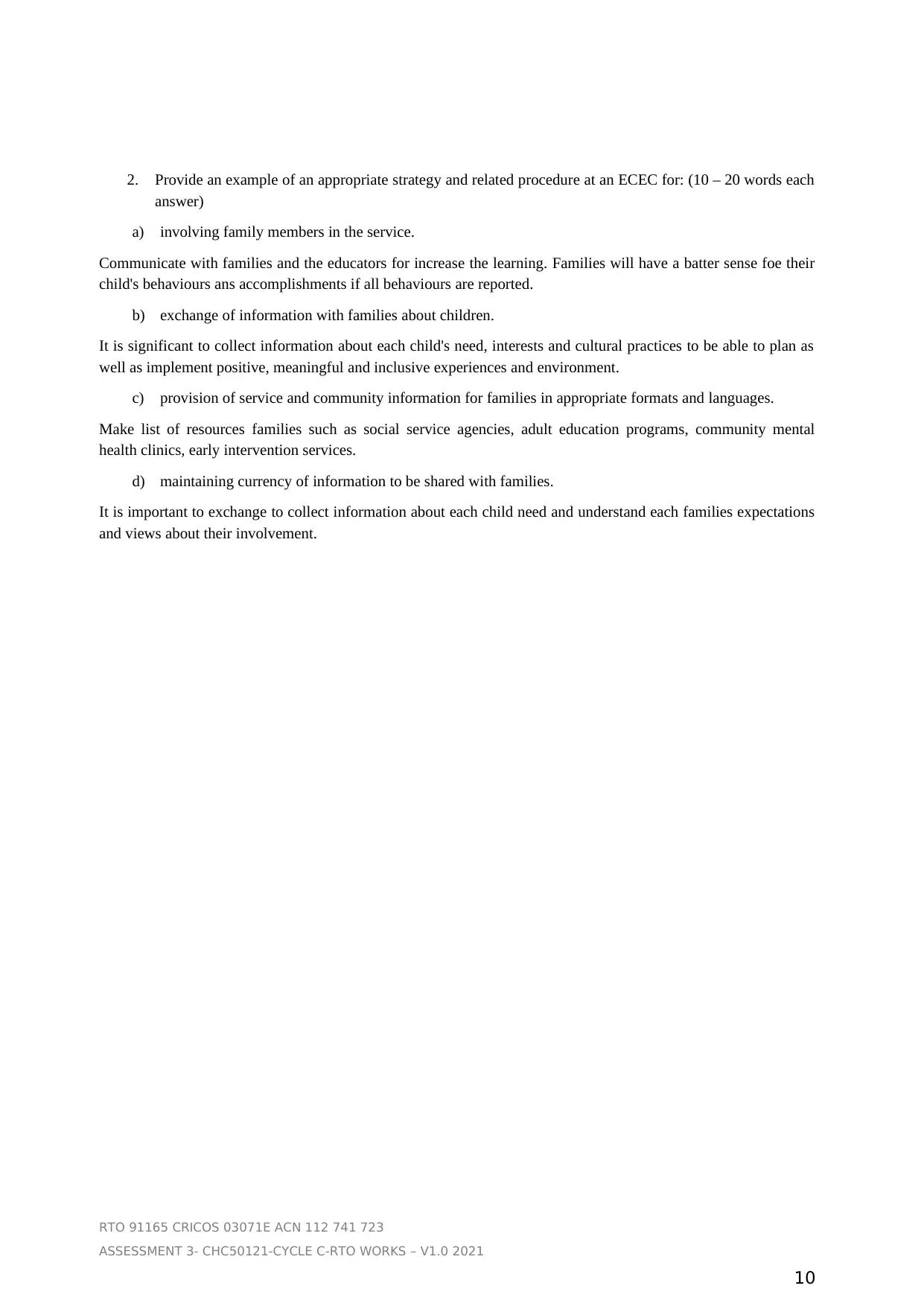
2. Provide an example of an appropriate strategy and related procedure at an ECEC for: (10 – 20 words each
answer)
a) involving family members in the service.
Communicate with families and the educators for increase the learning. Families will have a batter sense foe their
child's behaviours ans accomplishments if all behaviours are reported.
b) exchange of information with families about children.
It is significant to collect information about each child's need, interests and cultural practices to be able to plan as
well as implement positive, meaningful and inclusive experiences and environment.
c) provision of service and community information for families in appropriate formats and languages.
Make list of resources families such as social service agencies, adult education programs, community mental
health clinics, early intervention services.
d) maintaining currency of information to be shared with families.
It is important to exchange to collect information about each child need and understand each families expectations
and views about their involvement.
RTO 91165 CRICOS 03071E ACN 112 741 723
ASSESSMENT 3- CHC50121-CYCLE C-RTO WORKS – V1.0 2021
10
answer)
a) involving family members in the service.
Communicate with families and the educators for increase the learning. Families will have a batter sense foe their
child's behaviours ans accomplishments if all behaviours are reported.
b) exchange of information with families about children.
It is significant to collect information about each child's need, interests and cultural practices to be able to plan as
well as implement positive, meaningful and inclusive experiences and environment.
c) provision of service and community information for families in appropriate formats and languages.
Make list of resources families such as social service agencies, adult education programs, community mental
health clinics, early intervention services.
d) maintaining currency of information to be shared with families.
It is important to exchange to collect information about each child need and understand each families expectations
and views about their involvement.
RTO 91165 CRICOS 03071E ACN 112 741 723
ASSESSMENT 3- CHC50121-CYCLE C-RTO WORKS – V1.0 2021
10
Paraphrase This Document
Need a fresh take? Get an instant paraphrase of this document with our AI Paraphraser
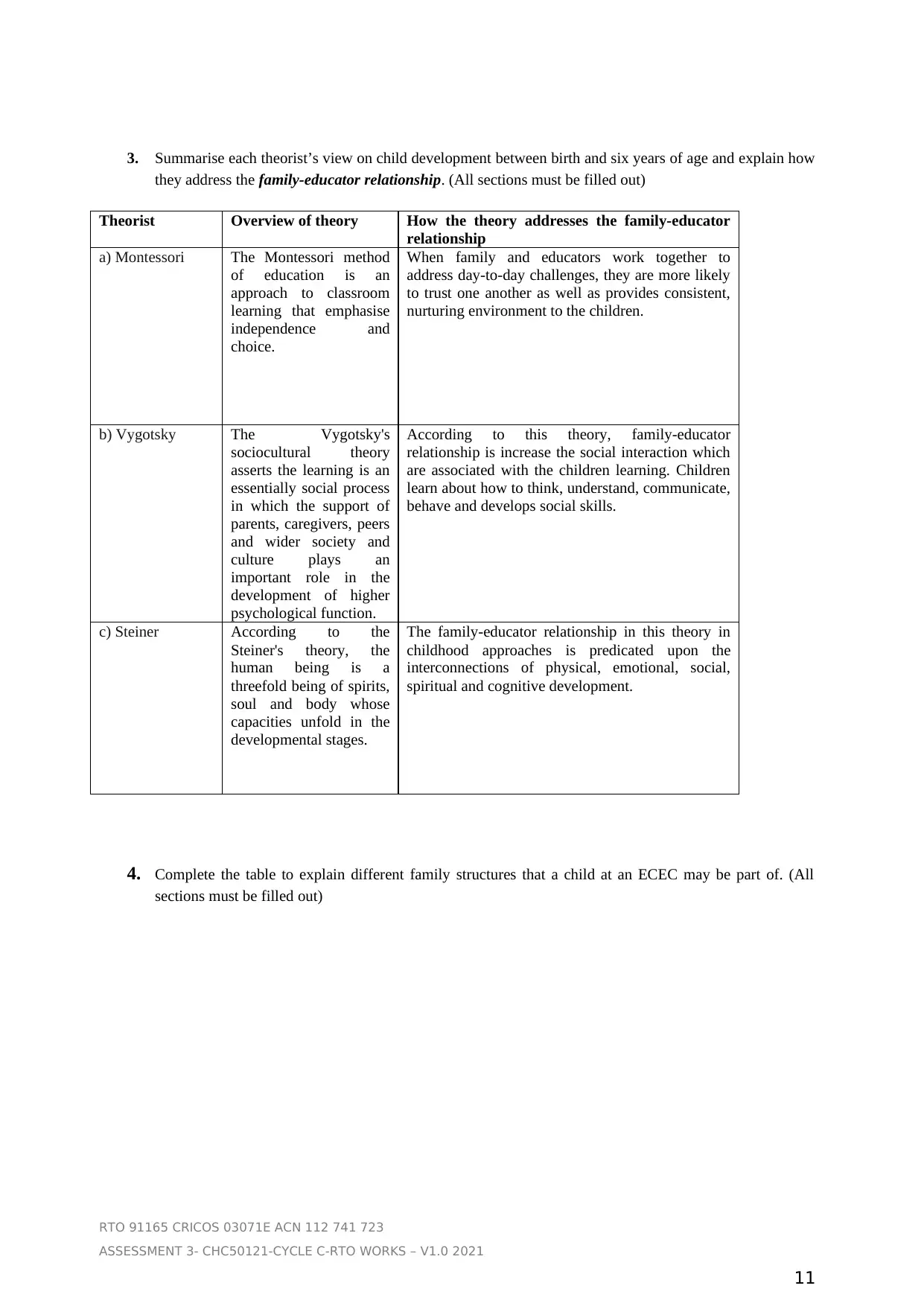
3. Summarise each theorist’s view on child development between birth and six years of age and explain how
they address the family-educator relationship. (All sections must be filled out)
4. Complete the table to explain different family structures that a child at an ECEC may be part of. (All
sections must be filled out)
RTO 91165 CRICOS 03071E ACN 112 741 723
ASSESSMENT 3- CHC50121-CYCLE C-RTO WORKS – V1.0 2021
11
Theorist Overview of theory How the theory addresses the family-educator
relationship
a) Montessori The Montessori method
of education is an
approach to classroom
learning that emphasise
independence and
choice.
When family and educators work together to
address day-to-day challenges, they are more likely
to trust one another as well as provides consistent,
nurturing environment to the children.
b) Vygotsky The Vygotsky's
sociocultural theory
asserts the learning is an
essentially social process
in which the support of
parents, caregivers, peers
and wider society and
culture plays an
important role in the
development of higher
psychological function.
According to this theory, family-educator
relationship is increase the social interaction which
are associated with the children learning. Children
learn about how to think, understand, communicate,
behave and develops social skills.
c) Steiner According to the
Steiner's theory, the
human being is a
threefold being of spirits,
soul and body whose
capacities unfold in the
developmental stages.
The family-educator relationship in this theory in
childhood approaches is predicated upon the
interconnections of physical, emotional, social,
spiritual and cognitive development.
they address the family-educator relationship. (All sections must be filled out)
4. Complete the table to explain different family structures that a child at an ECEC may be part of. (All
sections must be filled out)
RTO 91165 CRICOS 03071E ACN 112 741 723
ASSESSMENT 3- CHC50121-CYCLE C-RTO WORKS – V1.0 2021
11
Theorist Overview of theory How the theory addresses the family-educator
relationship
a) Montessori The Montessori method
of education is an
approach to classroom
learning that emphasise
independence and
choice.
When family and educators work together to
address day-to-day challenges, they are more likely
to trust one another as well as provides consistent,
nurturing environment to the children.
b) Vygotsky The Vygotsky's
sociocultural theory
asserts the learning is an
essentially social process
in which the support of
parents, caregivers, peers
and wider society and
culture plays an
important role in the
development of higher
psychological function.
According to this theory, family-educator
relationship is increase the social interaction which
are associated with the children learning. Children
learn about how to think, understand, communicate,
behave and develops social skills.
c) Steiner According to the
Steiner's theory, the
human being is a
threefold being of spirits,
soul and body whose
capacities unfold in the
developmental stages.
The family-educator relationship in this theory in
childhood approaches is predicated upon the
interconnections of physical, emotional, social,
spiritual and cognitive development.
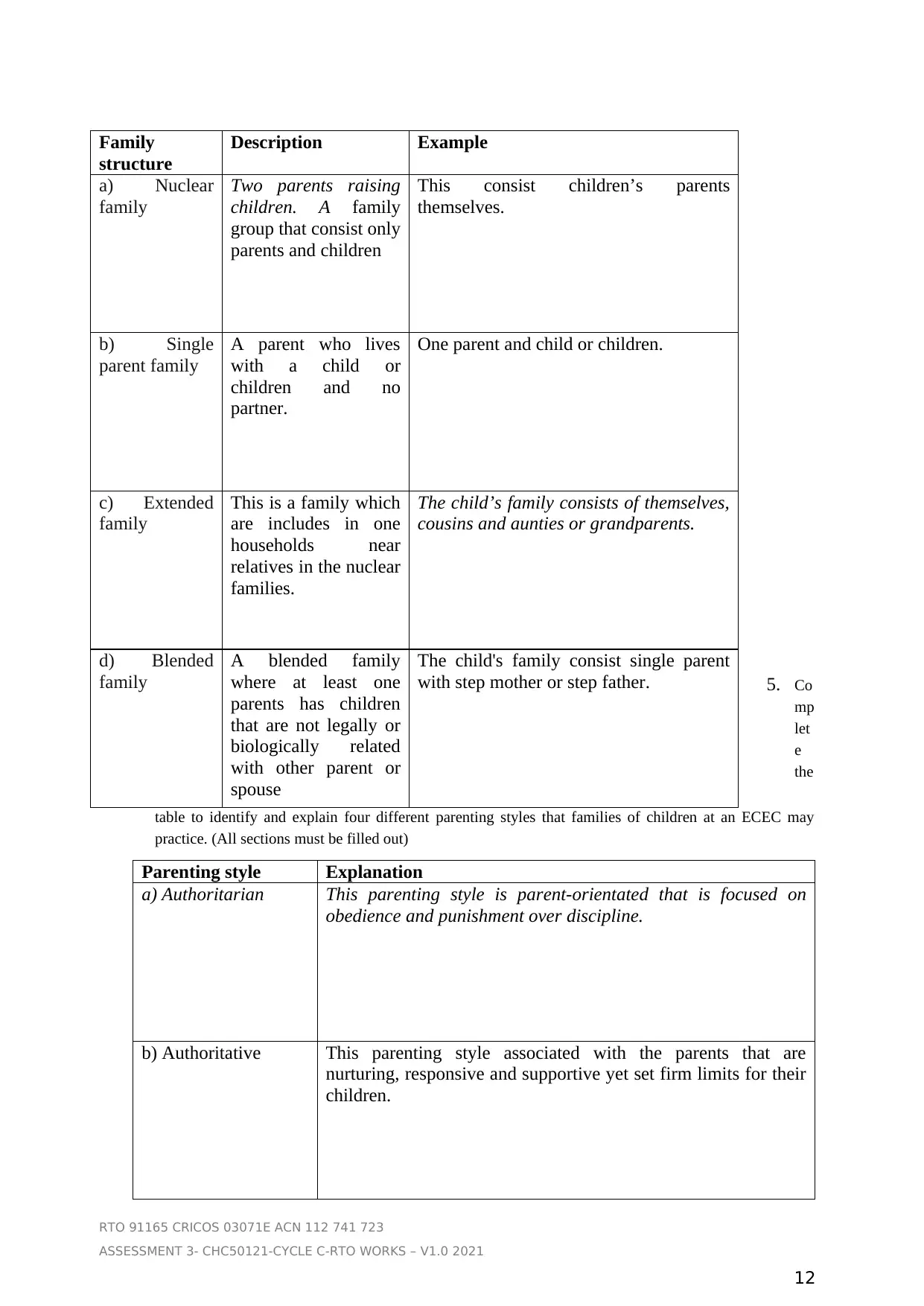
5. Co
mp
let
e
the
table to identify and explain four different parenting styles that families of children at an ECEC may
practice. (All sections must be filled out)
Parenting style Explanation
a) Authoritarian This parenting style is parent-orientated that is focused on
obedience and punishment over discipline.
b) Authoritative This parenting style associated with the parents that are
nurturing, responsive and supportive yet set firm limits for their
children.
RTO 91165 CRICOS 03071E ACN 112 741 723
ASSESSMENT 3- CHC50121-CYCLE C-RTO WORKS – V1.0 2021
12
Family
structure
Description Example
a) Nuclear
family
Two parents raising
children. A family
group that consist only
parents and children
This consist children’s parents
themselves.
b) Single
parent family
A parent who lives
with a child or
children and no
partner.
One parent and child or children.
c) Extended
family
This is a family which
are includes in one
households near
relatives in the nuclear
families.
The child’s family consists of themselves,
cousins and aunties or grandparents.
d) Blended
family
A blended family
where at least one
parents has children
that are not legally or
biologically related
with other parent or
spouse
The child's family consist single parent
with step mother or step father.
mp
let
e
the
table to identify and explain four different parenting styles that families of children at an ECEC may
practice. (All sections must be filled out)
Parenting style Explanation
a) Authoritarian This parenting style is parent-orientated that is focused on
obedience and punishment over discipline.
b) Authoritative This parenting style associated with the parents that are
nurturing, responsive and supportive yet set firm limits for their
children.
RTO 91165 CRICOS 03071E ACN 112 741 723
ASSESSMENT 3- CHC50121-CYCLE C-RTO WORKS – V1.0 2021
12
Family
structure
Description Example
a) Nuclear
family
Two parents raising
children. A family
group that consist only
parents and children
This consist children’s parents
themselves.
b) Single
parent family
A parent who lives
with a child or
children and no
partner.
One parent and child or children.
c) Extended
family
This is a family which
are includes in one
households near
relatives in the nuclear
families.
The child’s family consists of themselves,
cousins and aunties or grandparents.
d) Blended
family
A blended family
where at least one
parents has children
that are not legally or
biologically related
with other parent or
spouse
The child's family consist single parent
with step mother or step father.
⊘ This is a preview!⊘
Do you want full access?
Subscribe today to unlock all pages.

Trusted by 1+ million students worldwide
1 out of 23
Related Documents
Your All-in-One AI-Powered Toolkit for Academic Success.
+13062052269
info@desklib.com
Available 24*7 on WhatsApp / Email
![[object Object]](/_next/static/media/star-bottom.7253800d.svg)
Unlock your academic potential
Copyright © 2020–2025 A2Z Services. All Rights Reserved. Developed and managed by ZUCOL.





